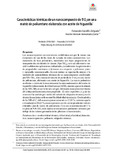Mostrar el registro sencillo del ítem
Terrestrial heat flow evaluation from thermal response tests combined with temperature profiling
| dc.creator | Vélez Márquez M.I. | |
| dc.creator | Raymond J. | |
| dc.creator | Blessent D. | |
| dc.creator | Philippe M. | |
| dc.date | 2019 | |
| dc.date.accessioned | 2020-04-29T14:53:42Z | |
| dc.date.available | 2020-04-29T14:53:42Z | |
| dc.identifier.issn | 14747065 | |
| dc.identifier.uri | http://hdl.handle.net/11407/5699 | |
| dc.description | The terrestrial heat flux density, an essential information to evaluate the deep geothermal resource potential, is rarely defined over urban areas where energy needs are important. In an effort to fill this gap, the subsurface thermal conductivity estimated during two thermal response tests was coupled with undisturbed temperature profile measurements conducted in the same boreholes to infer terrestrial heat flow near the surface. The undisturbed temperature profiles were reproduced with an inverse numerical model of conductive heat transfer, where the optimization of the model bottom boundary condition allows determining the near-surface heat flow. The inverse numerical simulation approach was previously validated by optimizing a steady-state and synthetic temperature profile calculated with Fourier's Law. Data from two thermal response tests in ground heat exchangers of one hundred meters depth were analyzed with inverse numerical simulations provided as examples for the town of Québec City, Canada, and Orléans, France. The temperature profiles measured at the sites and corrected according to the paleoclimate effects of the quaternary glaciations were reproduced with the model. The approach presented offers an alternative to assess heat flow in the preliminary exploration of deep geothermal resources of urban areas, where thermal response tests may be common while deep wells are sparsely distributed over the area to assess heat flow. © 2019 Elsevier Ltd | |
| dc.language.iso | eng | |
| dc.publisher | Elsevier Ltd | |
| dc.relation.isversionof | https://www.scopus.com/inward/record.uri?eid=2-s2.0-85069710860&doi=10.1016%2fj.pce.2019.07.002&partnerID=40&md5=e61d9d1ef6a2a5719bda18b99cf1b182 | |
| dc.source | Physics and Chemistry of the Earth | |
| dc.subject | Geothermal | |
| dc.subject | Heat flow | |
| dc.subject | Paleoclimate | |
| dc.subject | Temperature profile | |
| dc.subject | Thermal conductivity | |
| dc.subject | Thermal response test | |
| dc.subject | Geophysics | |
| dc.subject | Geothermal fields | |
| dc.subject | Glacial geology | |
| dc.subject | Heat exchangers | |
| dc.subject | Heat flux | |
| dc.subject | Heat transfer | |
| dc.subject | Numerical models | |
| dc.subject | Temperature control | |
| dc.subject | Testing | |
| dc.subject | Bottom boundary conditions | |
| dc.subject | Conductive heat transfer | |
| dc.subject | Geothermal | |
| dc.subject | Ground heat exchangers | |
| dc.subject | Numerical simulation approaches | |
| dc.subject | Paleoclimates | |
| dc.subject | Temperature profiles | |
| dc.subject | Thermal response test | |
| dc.subject | Thermal conductivity | |
| dc.title | Terrestrial heat flow evaluation from thermal response tests combined with temperature profiling | |
| dc.type | Article | eng |
| dc.rights.accessrights | info:eu-repo/semantics/restrictedAccess | |
| dc.publisher.program | Ingeniería Ambiental;Ingeniería en Energía | |
| dc.identifier.doi | 10.1016/j.pce.2019.07.002 | |
| dc.publisher.faculty | Facultad de Ingenierías | |
| dc.affiliation | Vélez Márquez, M.I., Centre Eau Terre Environnement, Institut national de la recherche scientifique, 490 rue de la couronne, Québec, Qc, Canada; Raymond, J., Centre Eau Terre Environnement, Institut national de la recherche scientifique, 490 rue de la couronne, Québec, Qc, Canada; Blessent, D., Programa de Ingeniería Ambiental, Universidad de Medellín, Carrera 87 N° 30 65, Medellín, Colombia; Philippe, M., Georesources Division, BRGM, 3 avenue Claude Guillemin, BP 36009, Orléans Cedex 2, 45060, France | |
| dc.relation.references | Allis, R.G., The effect of Pleistocene climatic variations on the geothermal regime in Ontario: a reassessment (1978) Can. J. Earth Sci., 16 (7), p. 1517 | |
| dc.relation.references | Aziz, A.K., Monk, P., Continuous finite elements in space and time for the heat equation (1989) Math. Comput., 52 (186), pp. 255-274 | |
| dc.relation.references | Bédard, K., Comeau, F.A., Raymond, J., Gloaguen, E., Comeau, G., Millet, E., Foy, S., Cartographie de la conductivité thermique des Basses-Terres du Saint-Laurent. Rapport de recherche (R1789) (2018), INRS, Centre Eau Terre Environnement Québec | |
| dc.relation.references | Bédard, K., Comeau, F.A., Raymond, J., Malo, M., Nasr, M., Geothermal characterization of the St. Lawrence Lowlands sedimentary basin, Québec, Canada (2017) Nat. Resour. Res., , 10.1007/s11053-017-9363-2 | |
| dc.relation.references | Bédard, K., Raymond, J., Malo, M., Konstantinovskaya, E., Minea, V., St. Lawrence Lowlands bottom-hole temperature: various correction methods (2014) GRC Trans., 38, pp. 351-355 | |
| dc.relation.references | Bédard, K., Comeau, F.A., Malo, M., Capacité effective de stockage géologique du CO2 dans le bassin des Basses-Terres du Saint-Laurent (No. INRSCO2 2012 V3.1) (2012), Institut national de la recherche scientifique - Centre Eau Terre Environnement Québec, Canada | |
| dc.relation.references | Beck, A.E., Climatically perturbed temperature gradients and their effect on regional and continental heat-flow means (1977) Tectonophysics, 41 (1), pp. 17-39 | |
| dc.relation.references | Bodri, L., Cermak, V., CHAPTER 2 - climate change and subsurface temperature (2007) Borehole Climatology, pp. 37-173. , Elsevier Oxford | |
| dc.relation.references | COMSOL, A.B., COMSOL Multiphysics Reference Manual. Stockholm (2016) | |
| dc.relation.references | COMSOL, A.B., Optimization Module User's Guide, Version 4.4. Stockholm (2013) | |
| dc.relation.references | Conn, A.R., Scheinberg, K., Vicente, L.N., (2009) Introduction to Derivative-free Optimization, 8. , Siam Philadelfia | |
| dc.relation.references | Dabral, V., Kapoor, S., Dhawan, S., Numerical simulation of one dimensional heat equation: B-spline finite element method (2011) Indian J. Comput. Sci. Eng. (IJCSE), 2, pp. 222-235 | |
| dc.relation.references | Davies, J.H., Global map of solid Earth surface heat flow (2013) Geochem. Geophys. Geosyst., 14 (10), pp. 4608-4622 | |
| dc.relation.references | Fou, T.-K.J., Thermal Conductivity and Heat Flow at St. Jerôme, Quebec (1969), (M.Sc. Thesis) McGill University Montreal, Canada | |
| dc.relation.references | Golovanova, I.V., Sal'manova, R.Y., Tagirova, C.D., Method for deep temperature estimation with regard to the paleoclimate influence on heat flow (2014) Russ. Geol. Geophys., 55 (9), pp. 1130-1137 | |
| dc.relation.references | Hartmann, A., Rath, V., Uncertainties and shortcomings of ground surface temperature histories derived from inversion of temperature logs (2005) J. Geophys. Eng., 2 (4), p. 299 | |
| dc.relation.references | Jessop, A.M., (1990) Chapter 3 - Analysis and Correction of Heat Flow on Land. Thermal Geophysics, 17, pp. 57-85. , Elsevier Amsterdam | |
| dc.relation.references | Majorowicz, J.A., Minea, V., Geothermal energy potential in the St-Lawrence river area, Québec (2012) Geothermics, 43, pp. 25-36 | |
| dc.relation.references | Majorowicz, J., Wybraniec, S., New terrestrial heat flow map of Europe after regional paleoclimatic correction application (2011) Int. J. Earth Sci., 100 (4), pp. 881-887 | |
| dc.relation.references | Majorowicz, J., afanda, J., Heat flow variation with depth in Poland: evidence from equilibrium temperature logs in 2.9-km-deep well Torun-1 (2008) Int. J. Earth Sci., 97 (2), pp. 307-315 | |
| dc.relation.references | Mareschal, J.C., Jaupart, C., Variations of surface heat flow and lithospheric thermal structure beneath the North American craton (2004) Earth Planet. Sci. Lett., 223 (1), pp. 65-77 | |
| dc.relation.references | Mareschal, J.C., Jaupart, C., Gariépy, C., Cheng, L.Z., Guillou-Frottier, L., Bienfait, G., Lapointe, R., Heat flow and deep thermal structure near the southeastern edge of the Canadian Shield (2000) Can. J. Earth Sci., 37 (2-3), pp. 399-414 | |
| dc.relation.references | Ouzzane, M., Eslami-Nejad, P., Badache, M., Aidoun, Z., New correlations for the prediction of the undisturbed ground temperature (2015) Geothermics, 53, pp. 379-384 | |
| dc.relation.references | Raymond, J., Lamarche, L., Malo, M., Extending thermal response test assessments with inverse numerical modeling of temperature profiles measured in ground heat exchangers (2016) Renew. Energy, 99, pp. 614-621 | |
| dc.relation.references | Raymond, J., Lamarche, L., Development and numerical validation of a novel thermal response test with a low power source (2014) Geothermics, 51, pp. 434-444 | |
| dc.relation.references | Sanner, B., Hellström, G., Spitler, J., Gehlin, S., More than 15 Years of Mobile Thermal Response Test A Summary of Experiences and Prospects (2013), European Geothermal Congress Pisa | |
| dc.relation.references | Sass, J.H., Beardsmore, G., Heat Flow Measurements, Continental. Encyclopedia of Solid Earth Geophysics (2011), pp. 569-573. , Springer Dordrecht | |
| dc.relation.references | Données thermiques (flux de chaleur et température) (2007), http://sigminesfrance.brgm.fr/geophy_flux.asp, Bureau de recherches géologiques et minières Orléans | |
| dc.relation.references | Saull, V.A., Clark, T.H., Doig, R.P., Butler, R.B., Terrestrial heat flow in the St. Lawrence Lowland of Québec (1962) Can. Min. Metall. Bull., 65, pp. 63-66 | |
| dc.relation.references | Velez-Marquez, M.I., Raymond, J., Blessent, D., Philippe, M., Simon, N., Bour, O., Lamarche, L., Distributed thermal response tests using a heating cable and fiber optic temperature sensing (2018) Energies, 11 (11), p. 3059 | |
| dc.relation.references | Westaway, R., Younger, P.L., Accounting for paleoclimate and topography: a rigorous approach to correction of the British geothermal dataset (2013) Geothermics, 48, pp. 31-51 | |
| dc.type.version | info:eu-repo/semantics/publishedVersion | |
| dc.type.driver | info:eu-repo/semantics/article |
Ficheros en el ítem
| Ficheros | Tamaño | Formato | Ver |
|---|---|---|---|
|
No hay ficheros asociados a este ítem. |
|||
Este ítem aparece en la(s) siguiente(s) colección(ones)
-
Indexados Scopus [1632]


